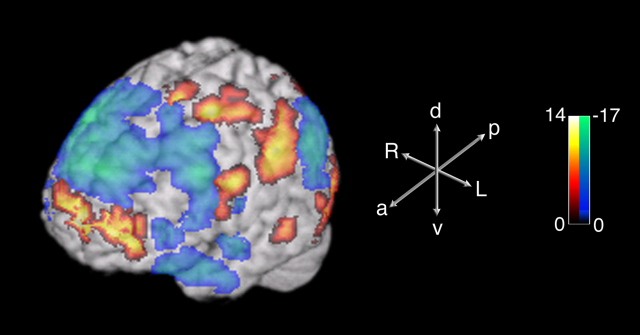This is the first of a two-part article about goes on in your head when you’re improvising music. In this part we’ll look at what’s happening in the brain during creative musical improvisation. In the second part we’ll look at the conscious experience of creative improvisation and tie it to what’s happening in the brain.
The image at the top is from a study published in 2008 by Dr. Charles Limb at Johns Hopkins and Dr. Allen Braun at NIH. They used functional magnetic resonance imaging (fMRI) technology to examine what was going on in the brain of highly trained jazz pianists while they were improvising. The yellow-orange-red colors show areas of high activation and the green-blue colors show areas of low activation.
 First, some background about fMRI. MRI is a non-invasive technology that provides detailed, high resolution images of internal structure. It is commonly used to diagnose injuries, internal structural defects, and cancers of various kinds. MRI alone does not provide any information about function.
First, some background about fMRI. MRI is a non-invasive technology that provides detailed, high resolution images of internal structure. It is commonly used to diagnose injuries, internal structural defects, and cancers of various kinds. MRI alone does not provide any information about function.
The “f” in fMRI refers to a technique for coupling information about activity in the brain to the high resolution pictures provided by MRI. Blood flow increases to areas of the brain that are highly active in order to provide the fuel that the active neurons are burning. This increase in blood flow can be monitored non-invasively while the brain activity is taking place by using a technique that measures magnetic differences between the oxygen-rich blood that is feeding the active neurons and blood that is oxygen poor after having fed the neurons.
Drs. Limb and Braun used this fMRI technique to examine brain activity in highly trained jazz pianists while they were improvising. Some of the scans from their study are shown in the image below. Each scan shows a horizontal slice through the brain beginning with a lower portion of the brain labeled -24 and ending with a higher portion of the brain labeled 60. The last picture on the bottom line shows the positions of the horizontal slices.
Dr. Braun and his colleagues carried out a similar study in 2012 that examined brain activity in accomplished freestyle rappers while they were improvising. The results for freestyle rappers were similar to the findings Limb and Braun had previously reported for jazz pianists.
What did they find?
 Limb and Braun compared brain activity when improvising with activity when playing a memorized musical passage and found an intriguing pattern of contrasting activation and deactivation in prefrontal cortex. Prefrontal cortex is the the area in the front of the brain that lies behind the forehead (shown in red in the image on the left). It appears to be the area of the brain where higher cognitive functions like planning, decision making, problem solving, and controlling and modifying behavior take place.
Limb and Braun compared brain activity when improvising with activity when playing a memorized musical passage and found an intriguing pattern of contrasting activation and deactivation in prefrontal cortex. Prefrontal cortex is the the area in the front of the brain that lies behind the forehead (shown in red in the image on the left). It appears to be the area of the brain where higher cognitive functions like planning, decision making, problem solving, and controlling and modifying behavior take place.
 In the studies involving jazz pianists and freestyle rappers an area of the prefrontal cortex called the medial prefrontal cortex, seen in the image on the right, showed an increased level of activity when improvising as compared to performing a memorized passage. The functions carried out in this area of the brain are not fully understood but research suggests medial prefrontal cortex is involved with maintaining a set of goals or intentions at a level that is independent of the specific behavior that is being carried out to accomplish the goals or fulfill the intentions. For the improvising musician, this might correspond to the intention of expressing an exuberant sense of joy or a quiet feeling of sadness that is independent of factors such as the technique need to play a particular instrument or the chord structure of the song being played.
In the studies involving jazz pianists and freestyle rappers an area of the prefrontal cortex called the medial prefrontal cortex, seen in the image on the right, showed an increased level of activity when improvising as compared to performing a memorized passage. The functions carried out in this area of the brain are not fully understood but research suggests medial prefrontal cortex is involved with maintaining a set of goals or intentions at a level that is independent of the specific behavior that is being carried out to accomplish the goals or fulfill the intentions. For the improvising musician, this might correspond to the intention of expressing an exuberant sense of joy or a quiet feeling of sadness that is independent of factors such as the technique need to play a particular instrument or the chord structure of the song being played.
 At the same time that medial prefrontal cortex is activated during improvisation, large areas of lateral prefrontal cortex are deactivated when improvising as compared to performing a memorized passage. In Limb and Braun’s studies the deactivation took place in the lateral orbitofrontal and dorsolateral prefrontal areas which are show in the image on the left.
At the same time that medial prefrontal cortex is activated during improvisation, large areas of lateral prefrontal cortex are deactivated when improvising as compared to performing a memorized passage. In Limb and Braun’s studies the deactivation took place in the lateral orbitofrontal and dorsolateral prefrontal areas which are show in the image on the left.
The lateral orbitofrontal area (shown in gray-blue in the image above) is thought to be involved in consciously monitoring behavior that is being carried out to achieve the goals that are maintained in the medial prefrontal area. It is also thought to be involved with inhibiting these behaviors if they are thought to be incorrect or socially inappropriate. When playing music, this area may be involved in inhibiting playing that strays too far outside constraints imposed by a narrow view of melodic, harmonic or rhythmic structure. Deactivation in this area could lower or remove this source of inhibition which would give the musician more freedom to improvise creatively.
The dorsolateral prefrontal area (shown in purple in the image above), which is also deactivated during improvisation, is thought to be involved with monitoring and adjusting sequences of learned behavior that require keeping the sequence in memory while the entire behavior is carried out. When playing music, this area may be involved in carrying out a well-practiced sequence of notes. Deactivation in this area could provide the musician with more freedom to improvise by decreasing the likelihood that the notes the musician is playing will follow well-practiced and commonly played routines.
Whether an improvising musician is a pianist or a rapper, their performance involves more than pure improvisation. The pianist must play a piano; the rapper must “play” his or her voice. In most cases the musical piece being played is not completely free of any kind of musical structure but is subject to some melodic, harmonic and/or rhythmic constraints. The brain (and spinal cord) must support the entire musical performance, not just the improvisational aspects of the performance. Processing this other information accounts for the activated and deactivated areas seen in the brain scans that are outside of the prefrontal cortex.
The areas of activation and deactivation in the prefrontal cortex appear to go a long way toward explaining how the purely improvisational part of a musical performance is carried out in the brain. Activation in the medial prefrontal cortex enhances the musician’s focus on the ideas or emotions he or she is trying to express. Deactivation in the lateral prefrontal cortex reduces the tendency to play highly memorized and often repeated sequences of notes and weakens the limitations imposed by playing within tightly constrained musical structures.
Although the research carried out by Drs. Limb and Braun does not address this issue, it would not be surprising to find that the activation and deactivation patterns they observed in prefrontal cortex are present when people are being creative in areas other than music. The focus on personal goals coupled with freedom from constraint that appear to be supported by these fMRI studies would seem to be involved with virtually any type of creativity and the areas of prefrontal cortex that are activated or deactivated in these studies are not specifically linked to anything having to do with playing a musical instrument or thinking in musical terms.
This article examined patterns of activation in the brain when a musician is improvising. In What Goes on in Your Head During Creative Musical Improvisation? Part 2 we link this brain activity to some of the ways musicians describe musical improvisation and creativity.






Pingback: What Goes on in Your Head During Creative Musical Improvisation? Part 2 | THE INFO MONKEY